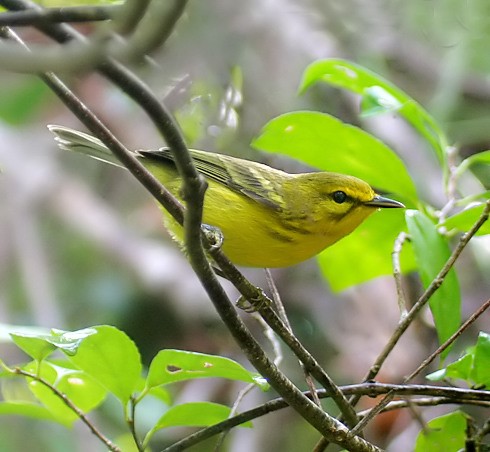Birdfinding.info ⇒ Common on all three of the Cayman Islands. On Grand Cayman, Botanic Park, the Mastic Trail, and North Side are reliable sites. Some travelers have found it during layovers at Owen Roberts International Airport by walking east from the terminal building and exploring the small network of dyke roads.
Vitelline Warbler
Setophaga vitellina
Endemic to the Cayman and Swan Islands (Honduran islets 200 miles southwest of Grand Cayman, and 100 miles north of eastern Honduras). As the Swans are not readily accessible, the Vitelline Warbler is effectively endemic to the Caymans, where it is common in dense woodlands and brush.
Identification
A bright yellow-and-olive warbler with essentially the same facial pattern as the more familiar Prairie Warbler, which winters in its range. Distinctions between the two species can be subtle and vary by sex and age.
Vitelline is very similar to female and immature Prairie Warblers, but yellower overall, and its markings are fainter, blurrier, and less constrasty. Vitelline’s wingbars are yellow, not white as in Prairie. (For a more detailed comparison, see below: Cf. Female Prairie Warbler.)

Vitelline Warbler, likely male with indistinct markings. (Queen Elizabeth II Botanic Park, Grand Cayman; January 5, 2018.) © Geoff Malosh
The sexes are quite similar, with differences that can be subtle and may vary seasonally. Some individuals appear intermediate, not clearly assignable to either sex.
Males typically show long, bold eyebrows and stronger contrast in the wings and facial markings. The contrasts may be most pronounced when males are in breeding condition.
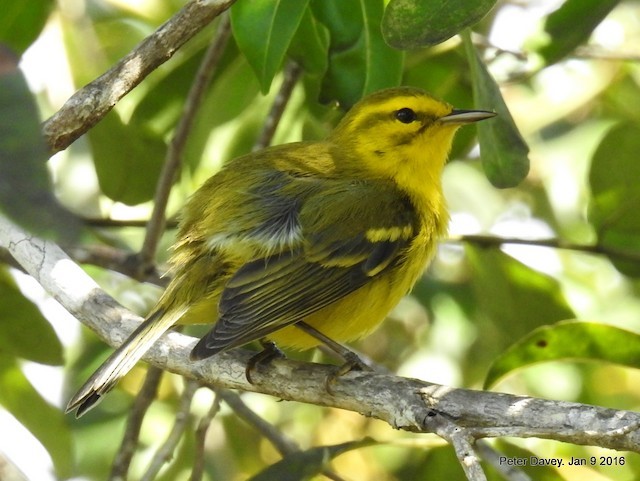
Vitelline Warbler, male showing bold eyebrow and strong contrasts in facial markings and wings. (East End, Grand Cayman; January 9, 2016.) © Peter Davey

Vitelline Warbler, male. (Queen Elizabeth II Botanic Park, Grand Cayman; March 3, 2018.) © Charles Davies
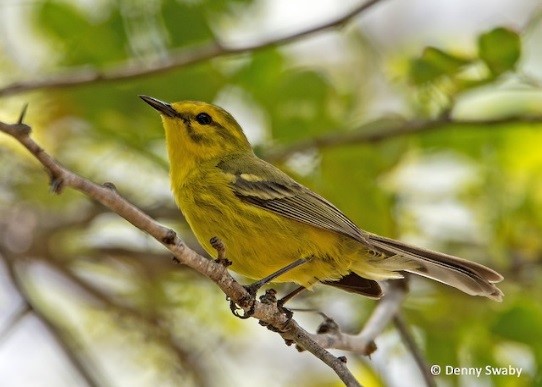
Vitelline Warbler, male showing somewhat indistinct eyebrow and weak contrast in the wings. (Queen Elizabeth II Botanic Park, Grand Cayman; May 5, 2018.) © Denny Swaby
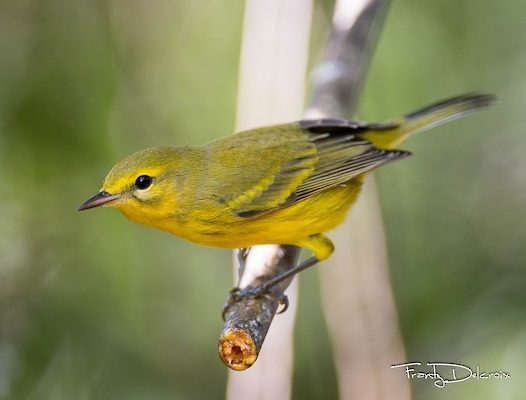
Vitelline Warbler, female. (Mastic Trail, Grand Cayman; November 2, 2017.) © Frantz Delcroix
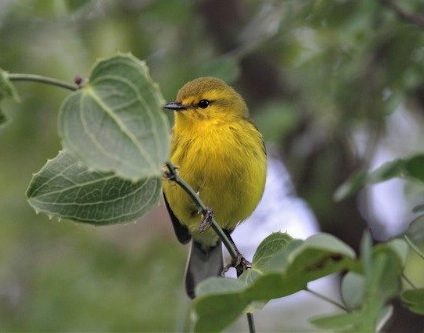
Vitelline Warbler, female. (Queen Elizabeth II Botanic Park, Grand Cayman; March 2, 2018.) © Charles Davies
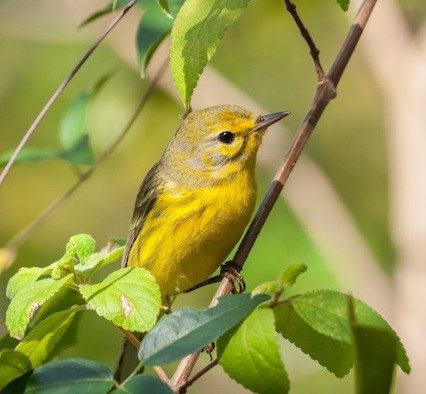
Vitelline Warbler, apparently female but showing bold facial markings. (North Side, Grand Cayman; February 25, 2009.) © Jim Hoover
Inter-Island Variation. The subspecies crawfordi, of Cayman Brac and Little Cayman, has more limited markings than the Grand Cayman subspecies. In crawfordi, the sexes appear to be essentially identical.
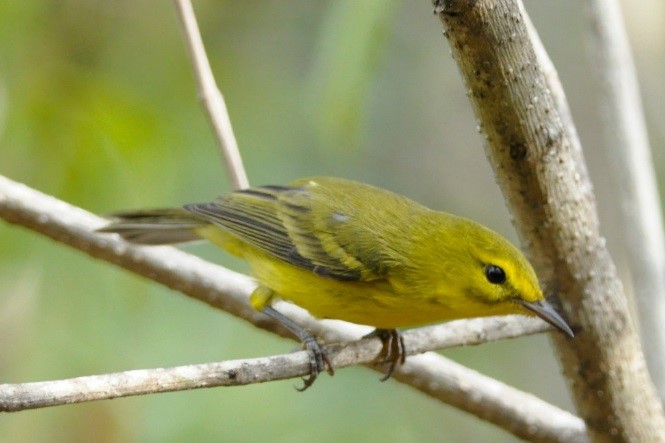
Vitelline Warbler, S. v. crawfordi. (Brac Parrot Reserve, Cayman Brac; December 28, 2014.) © Christine Kozlosky
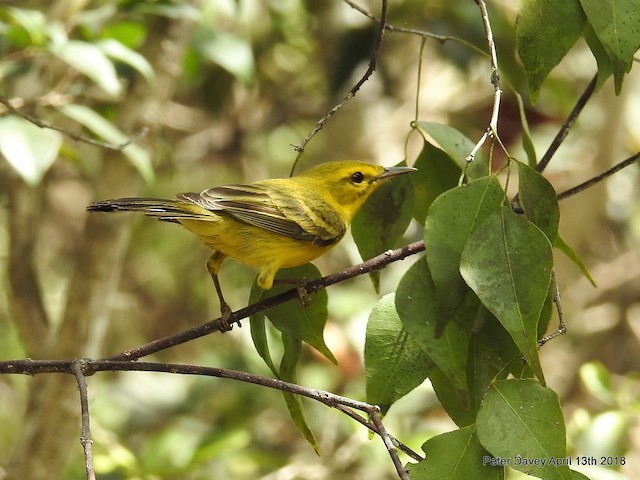
Vitelline Warbler, S. v. crawfordi. (Brac Parrot Reserve, Cayman Brac; April 13, 2018.) © Peter Davey

Vitelline Warbler, S. v. crawfordi. (Brac Parrot Reserve, Cayman Brac; December 26, 2014.) © Christine Kozlosky
Immature Vitelline Warblers appear to show more consistent sex differences than the adults.
Males show long, bold eyebrows, whereas females have very limited eyebrows and largely olive-gray heads.

Vitelline Warbler, immature male. (Savannah Grand, Grand Cayman; May 13, 2017.) © Peter Davey
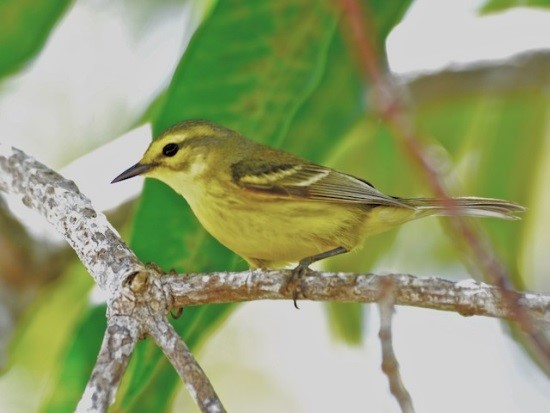
Vitelline Warbler, immature male. (North Side, Grand Cayman; March 19, 2013.) © Alan Van Norman

Vitelline Warbler, immature female. (Mastic Trail, Grand Cayman; December 12, 2007.) © Steve Metz

Vitelline Warbler, immature female. (Mastic Trail, Grand Cayman; August 11, 2018.) © Nick Ebanks
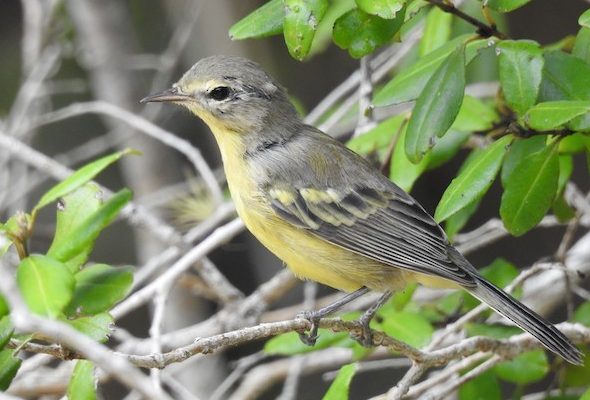
Vitelline Warbler, juvenile. (Queen Elizabeth II Botanic Park, Grand Cayman; May 21, 2017.) © Dany Garcia
Voice. Song is distinctive: a series of loud chips, then a combination of whistles and trills: chewy-chewy-CHEEE! cha-cheery-chee-HEEE!
Cf. Female Prairie Warbler. Both sexes of Vitelline Warbler strongly resemble the female Prairie Warbler. Following are the main visible features that distinguish Vitelline:
Weak Streaks: Female Prairie differs from Vitelline in having more extensive and bolder markings on the underparts: a blackish bar on the side of the neck and blackish streaks on the side that run from the chest to the flank. The streaks on Vitelline are usually confined to the side of the chest, becoming vague and blurry on the flanks. Vitelline’s streaks usually appear olive rather than blackish.
Yellower Upperparts: Vitelline’s upperparts are a yellower shade of olive than Prairie’s, and Vitelline has two well defined wingbars that almost always appear distinctly yellow. Female Prairie has indistinct wingbars.
More Brow: Male Vitelline can often be recognized by its long, bold, yellow eyebrow. The females of both species have short eyebrows that end just behind the eye.
Notes
Polytypic species consisting of three recognized subspecies.
References
Curson, J. 2018. Vitelline Warbler (Setophaga vitellina). In Handbook of the Birds of the World Alive (J. del Hoyo, A. Elliott, J. Sargatal, D.A. Christie, and E. de Juana, eds.). Lynx Edicions, Barcelona. https://www.hbw.com/node/61487. (Accessed November 27, 2018.)
eBird. 2018. eBird: An online database of bird distribution and abundance. Cornell Lab of Ornithology, Ithaca, N.Y. http://www.ebird.org. (Accessed November 27, 2018.)
Raffaele, H., J. Wiley, O. Garrido, A. Keith, and J. Raffaele. 1998. A Guide to the Birds of the West Indies. Princeton University Press, Princeton, N.J.
